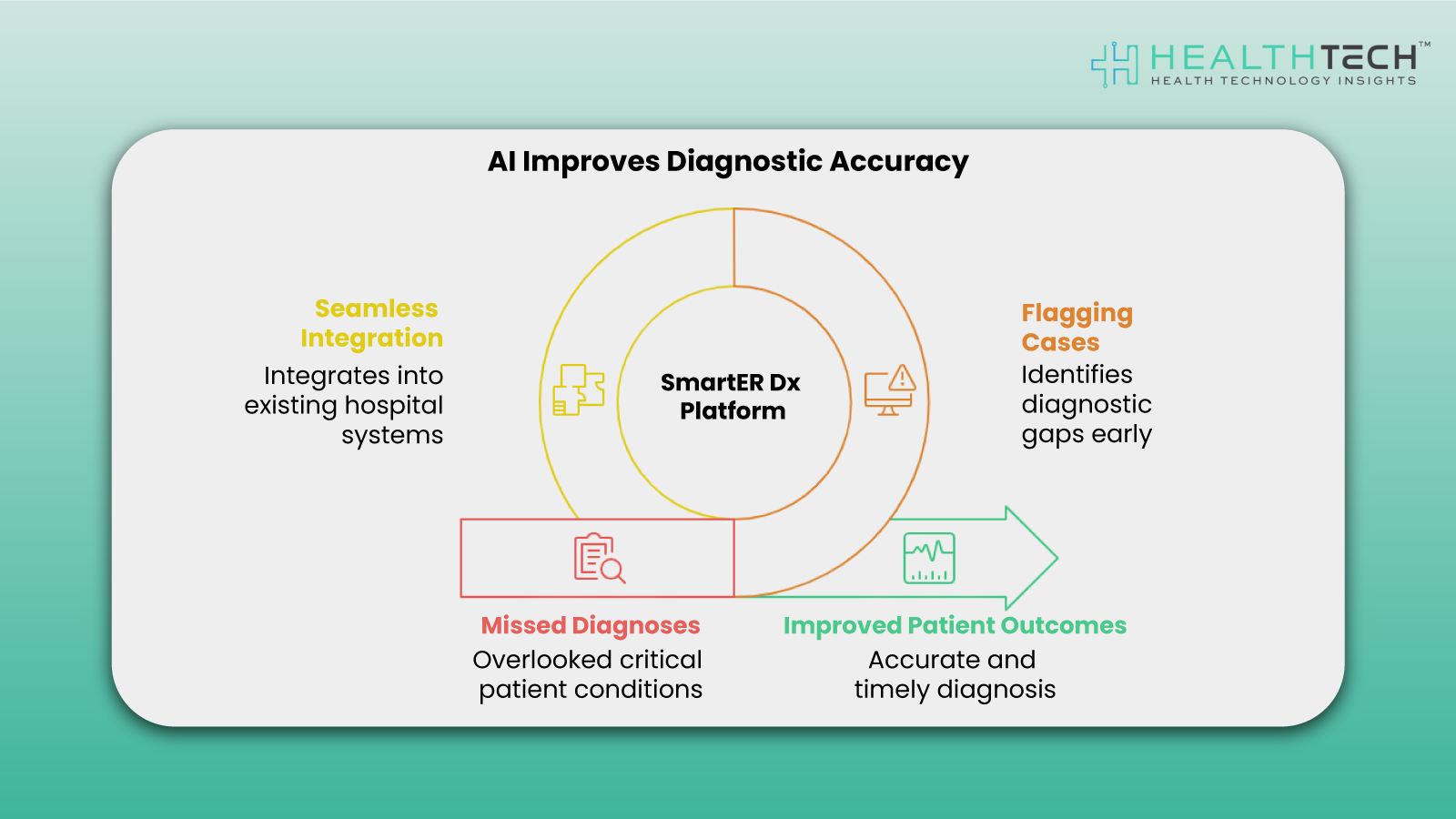SmartER Dx is solving a very real, very old problem with fresh precision: helping doctors catch what the human eye and mind might miss under pressure.
Emergency departments have always been where chaos meets critical care. But today, they’re also becoming the proving ground for next-gen clinical intelligence. AI is no longer confined to research papers or pilot projects; it’s showing up where it counts most: in real time, alongside overburdened teams, quietly closing gaps in clinical decision-making.
So why is this particular startup standing out in a crowded field of AI players? Why are leading investors lining up to back its growth? To understand that, we need to rewind to where it all began, not in a boardroom, but on a hospital floor.
The Story Behind SmartER Dx’s Momentum
It’s one thing to prototype an AI tool in a quiet lab. It’s another entirely to design it in between overnight shifts, surrounded by exhausted clinicians and blinking monitors.
That’s where this story begins.
SmartER Dx was co-founded by two physicians who lived the ER grind firsthand. Dr. Mike Gao, a former resident physician, and Dr. Jake Lancaster, a hospital executive and practicing internist, spent years watching diagnoses get delayed or missed, not out of negligence, but because the clinical picture was incomplete, the system was fragmented, and time was never on their side.
Instead of building a one-size-fits-all AI solution, they zoomed in on one of the most vulnerable moments in the care continuum: discharge. That’s when decisions must be made quickly, with incomplete data and an immense cognitive load. One overlooked detail, a lab trend, a subtle pattern in vitals, a single line in a physician’s note, can change everything.
So they built SmartER Dx to serve as a safety net. The platform doesn’t just “use AI.” It uses explainable, clinician-informed AI to sift through structured and unstructured patient data, labs, notes, vitals, and medications and surface possible diagnoses that may have been missed. It acts like a second set of clinical eyes, always alert, never tired.
This clarity of vision and clinical grounding is why investors are so bullish on SmartER Dx and the future of AI in emergency medicine. It wasn’t designed to impress in a demo. It was made to matter in a real hospital, during real cases, for real clinicians.
As Steve Kraus, partner at Bessemer Venture Partners, who led their $5 million seed round, summed it up: “SmartER Dx doesn’t just ‘do AI.’ It delivers results in the most complex clinical environment, on day one.”
What SmartER Dx Is Getting Right in the ER
AI either fits into the workflow and improves care, or it gets ignored. There’s no time for dashboards that require training or predictions that aren’t explainable. Doctors need tools that enhance their thinking, not add to their burden.
That’s where SmartER Dx truly shines.
Take Baptist Memorial Health Care in Tennessee. There, SmartER Dx has flagged missed diagnoses in more than 8% of emergency department discharges. Let that sink in. That’s 8 out of every 100 patients who might have gone home without the full picture, had it not been for the AI raising its hand.

In one case, SmartER Dx flagged a potential pulmonary embolism, a life-threatening condition, that had slipped through during the initial assessment. The platform had connected the dots between an elevated D-dimer, slightly irregular vitals, and an offhand note from the attending. The human team hadn’t caught it yet. The AI did.
And crucially, it did so without asking the team to change how they work.
The tool integrates directly into existing electronic health records (EHRs) and operates during the discharge workflow. No separate log-ins. No complex prompts. No extra steps. Just meaningful, interpretable insights presented when it matters most.
This frictionless design is winning over not just clinicians but hospital administrators, too. When technology improves outcomes and doesn’t disrupt operations, it becomes a no-brainer.
“We’ve seen tools that promise to change the game. SmartER Dx actually has. It finds what we sometimes miss.”, said Dr. Jeffrey Wright, Chief Medical Officer of Baptist Memorial Hospital
And as the platform scales across more hospitals, it’s becoming increasingly clear why investors see it as more than just a point solution. They see it as infrastructure, a quiet force underpinning a smarter, safer future for emergency care.
They’re not just investing in software. They’re investing in trust.
And it’s precisely this trust, built from the ER floor up, that explains the rising momentum around SmartER Dx and the future of AI in emergency medicine.
The Future of AI in Emergency Medicine
When early-stage healthtech startups raise seed capital, the headlines often focus on the size of the round. But for seasoned investors, it’s never just about the money raised; it’s about where the conviction comes from.
What made SmartER Dx stand out? It wasn’t just the tech, but the clarity of the problem it solved. The team didn’t try to boil the ocean. They focused on a single, high-leverage moment in care: the discharge decision.
By enhancing that decision with AI-driven diagnosis suggestions, SmartER Dx didn’t just help doctors catch what they might have missed; it helped entire systems improve safety, trust, and throughput.
For investors looking to back the next generation of healthtech, this is the kind of model that checks every box: clinically grounded, outcome-oriented, and ready to scale.
According to Deloitte’s U.S. Health Systems AI Outlook, nearly two-thirds of hospitals now have a budget earmarked specifically for AI-based decision support, particularly tools that reduce diagnostic errors and enhance physician efficiency. And diagnostic accuracy is quickly rising to the top of priority lists as hospital leaders grapple with value-based care metrics, malpractice exposure, and physician burnout.
That’s why investors are backing SmartER Dx and the future of AI in emergency medicine. Because it’s not about replacing doctors. It’s about empowering them. Quietly. Reliably. And in a way that fits.
But perhaps even more compelling than what the company is doing today… is what it could unlock tomorrow.
Building the Blueprint for a Trusted AI in Healthcare
The emergency room is a crucible. If an AI platform can survive there, amid the noise, time pressure, fragmented data, and high stakes, it can likely thrive anywhere in healthcare.
And that’s what makes the SmartER Dx model so compelling.
While the company’s current focus is the ER, its value proposition doesn’t stop there. The same foundational principles that make it successful in emergency care, real-time data synthesis, explainable AI, seamless integration into clinician workflows, could have ripple effects across inpatient medicine, critical care units, and even rural hospitals managing with minimal clinical staffing.
It’s a platform built for expansion, but only when the time and use case are right.
Unlike many startups that spread too thin, too fast, SmartER Dx is scaling deliberately. Hospital by hospital. Department by department. Listening to physicians. Improving iteratively. That discipline may not make for flashy headlines, but it makes for lasting adoption.
And adoption is the currency that matters most in hospital innovation.
As the founders continue to grow their footprint, they’re not chasing a dozen problems at once. They’re staying obsessively focused on solving one problem exceptionally well, then earning the right to do more.
That long-game strategy is resonating with investors, clinicians, and healthcare executives alike. Because if SmartER Dx can consistently catch what humans miss, without getting in the way, then its potential becomes exponential.
“In the next wave of AI in healthcare, the winners won’t be the flashiest,” said Rachel Winokur, healthcare venture advisor and former executive at Bright Health. “They’ll be the ones solving a real clinical problem better than any human ever could, and earning the right to do more.”
And that’s exactly what we’re seeing in SmartER Dx and the future of AI in emergency medicine. A company that isn’t trying to steal the spotlight, but quietly, confidently, and carefully earning trust across the healthcare spectrum.
Because the future of AI in hospitals isn’t just about intelligence. It’s about credibility. And SmartER Dx is building that, one diagnosis and one discharge decision, at a time.
What This Signals for Healthcare Leaders, Innovators, and Policymakers
For years, health systems have been promised big things from AI. Predictive analytics. Workflow optimization. Clinical decision support. But much of that promise stayed stuck in pilots, procurement bottlenecks, or staff skepticism. Since most AI tools weren’t built for real environments with real stakes. They were designed for theoretical workflows, not for exhausted ER teams under pressure.
For healthcare leaders, this raises an important question: What if we’ve been asking too much from AI, and expecting too little of its design?
SmartER Dx doesn’t try to solve everything at once. It solves one thing well, then listens. It doesn’t replace expertise, it reinforces it. And that’s exactly the kind of mindset the industry should be doubling down on.
The future of hospital-based AI won’t be about dashboards or avatars. It’ll be about silent strength. Background brilliance. Systems that enhance clinical judgment without competing with it.
For policymakers, this also opens up a new policy frontier. Tools like SmartER Dx could become critical infrastructure. As reimbursement models evolve and diagnostic safety comes under sharper federal scrutiny, we need regulatory frameworks that reward platforms that measurably improve outcomes while respecting clinician autonomy.
As for hospital executives and CIOs? The takeaway is clear. If you want AI that sticks, adopt tools that start with the end-user, build around the workflow, and prove their value without a learning curve. SmartER Dx is doing exactly that. And more healthtech solutions should be held to the same standard.
Ultimately, what’s happening here isn’t just about AI. It’s about trust.
If we’re serious about building a smarter, more responsive, and more human health system, we’ll need more stories like SmartER Dx and the future of AI in emergency medicine, and fewer stories about tech that promised the world and delivered another training manual.
FAQs
1. I get that SmartER Dx uses AI, but what does that look like inside an ER?
Great question. Imagine a doctor making a split-second call on whether a patient can be safely discharged. They’ve got labs, notes, vitals, a crowded waiting room, and only so much bandwidth. That’s where SmartER Dx quietly steps in.
2. There are so many AI tools in healthcare right now. What makes this one stand out?
You’re not wrong, there’s a flood of AI solutions promising big things. But most of them ask too much from already overwhelmed clinicians. SmartER Dx is different because it respects how ER teams actually work.
3. Why are investors so excited about something so specific, like ER discharges?
Because that one moment, discharge is high stakes. Miss something there, and it can lead to complications, readmissions, or worse. SmartER Dx is laser-focused on making that moment smarter, and the data already shows it’s catching important diagnoses that would’ve been missed.
4. Could this kind of AI be useful outside of emergency departments too?
Absolutely. The ER is just the beginning. What SmartER Dx is building is a smarter way to support clinical decision-making, especially in fast-moving environments. Think of inpatient units, smaller hospitals with fewer specialists, or discharge planning in complex care settings.
5. I’m a healthcare leader. If I’m considering something like SmartER Dx, where should I start?
Start by asking this: Will this make my clinicians’ lives easier and improve patient care? With SmartER Dx, the answer has been yes. It doesn’t demand workflow changes, yet it improves diagnostic confidence. That’s a rare combo.
Dive deeper into the future of healthcare.
Keep reading on Health Technology Insights.
To participate in our interviews, please write to our HealthTech Media Room at sudipto@intentamplify.com




